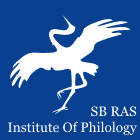 |
|
||||||||||||
|
Institute of Philology of
the Siberian Branch of Russian Academy of Sciences |
|
||||||||||||
|
|||||||||||||
| Sibirskii Filologicheskii Zhurnal (Siberian Journal of Philology) | |
|
Article
Authors: Timkin T. V. Institute of Philology of the Siberian Branch of the Russian Academy of Sciences, Novosibirsk, Russian Federation In the section Linguistics
Abstract: This paper describes the Surgut Khanty vowel articulation by ultrasonography methods. 193 vowel segments were sampled by Articulate Instruments equipment and processed with Ar-ticulate Assistant Advanced software. 97 consonant segments were recorded to estimate a contact influence of vowels on consonants. The data were collected from a woman, a Tromagan dialect native speaker born in 1970. The tongue contours were analyzed by certain features: the highest point and its coordinates, the most remote point and its distance from the coordinate center. The most distant point was found to allow distinguishing three basic tongue movement types according to J. Esling’s laryngeal articulator theory: front movement correlates with phonemes /i:/, /ɨ:/, /ɘ/, /ɛ/, raised movement correlates with phonemes /ʊ:/, /ɔ:/, /ɔ/, /o/, a combination of these two types yields /ʉ/, /ɨ:/, /o:/, and retracted movement is characteristic of phonemes /a:/, /a/. The vocal movement types can be differentiated by the most distant point number. The points 1–8 are placed in the frontal part of the dorsum, the points 9–16 are in the middle part, the points 17–24 are placed in the back part. Front vowels have the most distant point in the range 14–17. Retracted vowels and combination of front and raised position are characterized by 18–19 and raised vowels by 19–20. The distance of tongue shift within each type allows distinguishing individual phonemes. The radical plosive phoneme was proved experimentally to have velar allophone [k] and uvular allophone [q] depending on the vowel row. Keywords: Khanty language, Surgut dialect, experimental phonetics, ultrasonography, vowels, consonants Bibliography: Allen В., Pulleyblank D., Ajíbóyè Ọ. Articulatory mapping of Yoruba vowels: an ul-trasound study. Phonology. 2013, vol. 30, no. 2, pp. 183–210 Chepregi M. Surgutskiy dialekt khantyyskogo yazyka [Surgut dialect of Khanty]. Khanty-Mansiysk, 2016, 180 p. Esling J. There are no back vowels: the laryngeal articulator model. Canadian Jour-nal of Linguistics. Revue canadienne de linguistique. 2005, no. 50 (1/2/3/4), pp. 13–44. Gick В., Pulleyblank D., Campbell F., Mutaka Ng. Low vowels and transparency in Kinande vowel harmony. Phonology. 2006, vol. 23, no. 1, pp. 1–20. Gick B. The use of ultrasound for linguistic phonetic fieldwork. Journal of the In-ternational Phonetic Association. 2002, vol. 32, no. 2, pp. 113–121. Stolar S., Gick B. Аn index for quantifying tongue curvature. Canadian Acoustic. 2013, March, pp. 11–15. Tereshkin N. I. Slovar’ vostochnohantyjskih dialektov [East Khanty dialects dictionary]. Leningrad, Nauka, 1981, 544 p. Timkin T. V. Sistema glasnykh fonem surgutskogo dialekta khantyyskogo yazyka po dannym akusticheskoy fonetiki (v sopostavitel’nom aspekte) [Surgut Khanty vowel system based on acoustic data (in comparative aspect)]. Abstract of Cand. philol. sci. diss. Novosibirsk, 2021, 22 p. Timkin T. V. Vokalizm surgutskogo dialekta khantyyskogo yazyka po dannym elektromagnitnoy artikulografii [Surgut Khanty vowel system based on electromagnetic articulography data]. Languages and Folklore of Indigenous Peoples of Siberia. 2021, no. 2 (42), pp. 9–42. DOI 10.25205/2312-6337-2021-2-9-24 |
 |
Institute of Philology Nikolaeva st., 8, Novosibirsk, 630090, Russian Federation +7-383-330-15-18, ifl@philology.nsc.ru |
© Institute of Philology |


